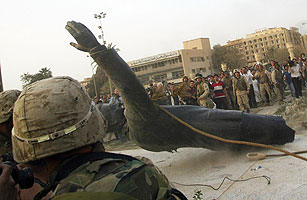
Less than two years after invading Afghanistan, the U.S. would enter a second conflict. On March 20, 2003 President George W. Bush announced in a televised address to the American people that, on his orders, coalition forces had begun striking targets in Iraq. The mission was twofold: disarm the country (from what, at the time, was thought to be weapons of mass destruction) and free the Iraqi people from Saddam Hussein's grip. A month after Baghdad fell to U.S. forces on April 9, 2003, Bush declared, under a banner that read "Mission Accomplished," that this was the end to major combat operations in the war effort, despite the fact that no WMDs had been found and Hussein, though no longer in power, was nowhere to be found. That would not remain the case. On December 13, 2003 Hussein was captured by U.S. forces in a "spider hole" at a farmhouse near Tikrit, and three years later, he was convicted and hanged. In 2010, Operation Iraqi Freedom drew to a close, and most of the U.S combat forces departed the nation, leaving about 50,000 to serve in a reduced capacity.